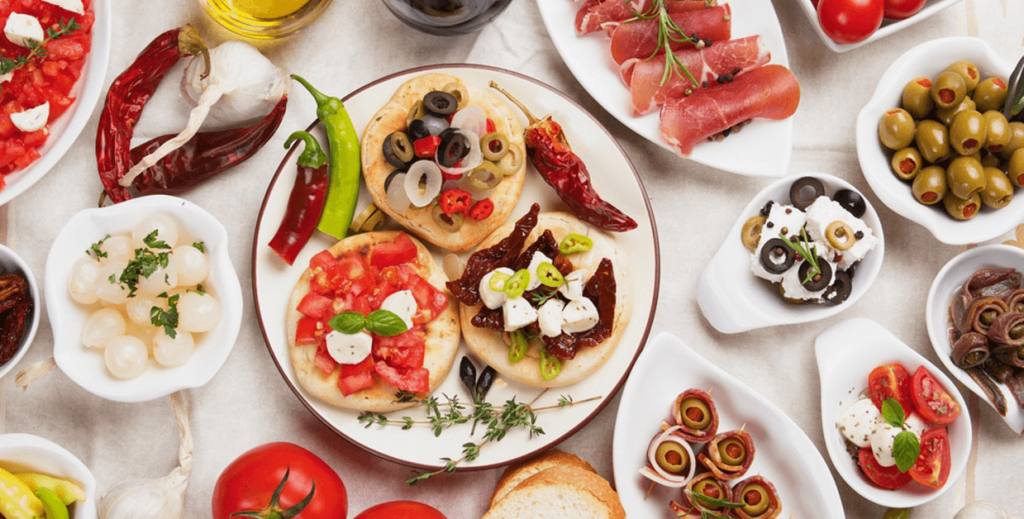These Spanish dishes you must have tasted
13 Mar 2018
Imagine for a moment hearing a horse whinny. No, you did not end up on a farm, but on the set of The Smartest Man. Turns out the horse can also talk and launches into the next question:
"What do you know about Spanish cuisine?"
Full of conviction, you race through the list: "Paella, tapas, gazpacho, tortilla, sangria, STOP!"
"Congratulations," said Erik Van Looy. You have every right to pat yourself on the back - you have just listed the five standard-bearers of Spanish cuisine at breakneck speed.

But of course it doesn't stop there. It is not true that Spaniards eat yellow rice with clams every day. We Belgians don't eat French fries every day, do we? No, a maximum of four times a week.
All kidding aside, Spain is a big country and each region has its own specialties.
For example, paella comes from Valencia. And even though there are characteristics that unite Spanish areas - lots of fresh produce, high-quality meat and fish, the abundant use of olive oil - each region, each town, each village has its own flavors, smells and colors.
In the Basque Country or Galicia, Asturias or Valencia - no, in no two restaurants will you eat the same dish. Or it would have to be at the burger joint with the yellow M....
And Italy and France may blow higher from the tower, but anyone who has ever put his legs under a table in Spain knows: Spanish cuisine is not inferior to that of its more famous neighbors.
Devour these dishes and you will automatically mumble your first Spanish words: MAS POR FAVOR!
Churros
https://www.instagram.com/p/BgJY8IGFb_z/?tagged=churros
You may already know this calorie bomb from the carnival. Perhaps even a hardcore diet guru like Sonja Kimpen could not resist these oblong deep-fried dough rolls. Spaniards buy churros at street stalls at parties or festivals, or eat this delicacy for breakfast. With powdered sugar, hot chocolate, dulce de leche (caramel spread) or dipped in coffee, the possibilities are endless.
Just as the origin of Belgian fries is being squabbled over, so too is the origin of these churros unclear. One popular theory believes that Spanish shepherds first made the delicacy. Since these could not just leave their sheep to get a pateeke at the bakery, they looked for other ways to satisfy their sweet tooth. Churros proved to be a great alternative, as the shepherds could easily prepare this "Spanish doughnut" on an open fire in a field.
Pulpo a la Gallega
https://www.instagram.com/p/BgJLf4dDNyX/?tagged=pulpoalagallega
Octopus is tastiest in northern Galicia. There, local chefs have found the right cooking time, the exact transition moment between rubbery and overcooked. They cook the squid in a copper saucepan, cut the flesh to pieces with scissors and season with paprika, coarse salt and olive oil.
Traditionally, this dish is served with bread on a wooden plate. The tentacles in particular are food for connoisseurs. The unwritten rule is that with pulpo a la gallega you don't drink water, you drink local young red wine. You may not mind.
Croquetas
https://www.instagram.com/p/BgJDY0Cgz3r/?tagged=croquetas
Every restaurant has its own recipe for making croquettes, often a well-kept secret passed down from generation to generation. There are some possibilities, such as with potatoes, cheese, ham or cod and béchamel sauce. Or how about blood sausage or creamy cheese? Those ingredients are then breaded and deep-fried.
Usually a restaurant's croquettes are a good indication of the quality of the cuisine, more than how ironed the waiter's advance is or how priced the items on the menu are. More so, often croquetas are tastiest in the traditional cheap canteens that Spaniards frequent.
Patatas Bravas
https://www.instagram.com/p/BgJK8rCglY-/?tagged=patatasbravas
Feel free to call this the Spanish answer to our French fries. This is one of the simplest and cheapest but at the same time most delicious dishes in Spain. The spicy sauce varies by region. Madrid eateries serve their patatas bravas, for example, with a tomato sauce with vinegar and red pepper, but garlic sauce is also always a good companion.
This dish tastes best in a simple café, tapas bar or a canteen where notary and construction worker sit elbow to elbow, preferably paired with a fresh pint.
Cocido madrileño
https://www.instagram.com/p/BETfYRtgCEv/?tagged=cocidomadrile%C3%B1o
You might not suspect it when you are slowly sauteing on a beach chair on the Costa Blanca at 30°C, but in some Spanish regions it can get quite cold. Many Spaniards swear by all kinds of stews to warm themselves up in winter.
Fortunately, Spain grows many beans and fresh vegetables that, combined with meat, lend themselves perfectly to it. Stews vary from region to region. For example, the inhabitants of mountainous (and unfortunately therefore cold and wet) Cantabria are enamored of their cocido montañes, literally: mountain stew. Another popular variety is fabada asturiana from Asturias.
But we opt in this review for a Madrid stew of chickpeas, vegetables such as potatoes, cabbage, carrots and turnips, and the requisite meat. Pork fat, bacon, chorizo, blood sausage or serrano ham, it all fits this cocido madrileño. This dish may have been around since the Middle Ages, but Madrileans are as fond of it as ever.
Horchata
https://www.instagram.com/p/BgI5BeMD9Rd/?tagged=horchata
Suppose you're in Valencia in the summer and it's oppressively hot (as a matter of fact, it is all-time). Your armpit ponds have long since ceased to be ponds, rather oceans, and you resolve to hang a "pool" sign next to them and start soliciting income. And you are thirsty, such an acute thirst that an ordinary glass of water cannot quench. In short, you desperately need a glass of horchata, or orxata as the Valencians call it.
Horchata is made from almonds, water and sugar - ice cold it is wonderfully refreshing. The Moors brought this drink to Spanish places, and many legends circulate about the origin of its name. Our favorite reads as follows. When a peasant girl gave a glass to the King of Aragon, the latter asked what it was. Milk, the girl replied. To which the king replied, "
Açò no és llet, açò és OR, XATA
!" Orte: this is not milk, dear, this is gold!" no idea if it's true, but at least it's a fun story.
Feel like snacking on these treats every day? It doesn't have to be a dream.
E
a second home in Spain is less unattainable than you may think.
N
e contact Gold Estates without obligation and we will help you on your way to your dream home under the sun.
E
n your dream homes, that speaks volumes.
 But of course it doesn't stop there. It is not true that Spaniards eat yellow rice with clams every day. We Belgians don't eat French fries every day, do we? No, a maximum of four times a week.
All kidding aside, Spain is a big country and each region has its own specialties.
For example, paella comes from Valencia. And even though there are characteristics that unite Spanish areas - lots of fresh produce, high-quality meat and fish, the abundant use of olive oil - each region, each town, each village has its own flavors, smells and colors.
In the Basque Country or Galicia, Asturias or Valencia - no, in no two restaurants will you eat the same dish. Or it would have to be at the burger joint with the yellow M....
And Italy and France may blow higher from the tower, but anyone who has ever put his legs under a table in Spain knows: Spanish cuisine is not inferior to that of its more famous neighbors.
Devour these dishes and you will automatically mumble your first Spanish words: MAS POR FAVOR!
But of course it doesn't stop there. It is not true that Spaniards eat yellow rice with clams every day. We Belgians don't eat French fries every day, do we? No, a maximum of four times a week.
All kidding aside, Spain is a big country and each region has its own specialties.
For example, paella comes from Valencia. And even though there are characteristics that unite Spanish areas - lots of fresh produce, high-quality meat and fish, the abundant use of olive oil - each region, each town, each village has its own flavors, smells and colors.
In the Basque Country or Galicia, Asturias or Valencia - no, in no two restaurants will you eat the same dish. Or it would have to be at the burger joint with the yellow M....
And Italy and France may blow higher from the tower, but anyone who has ever put his legs under a table in Spain knows: Spanish cuisine is not inferior to that of its more famous neighbors.
Devour these dishes and you will automatically mumble your first Spanish words: MAS POR FAVOR!










